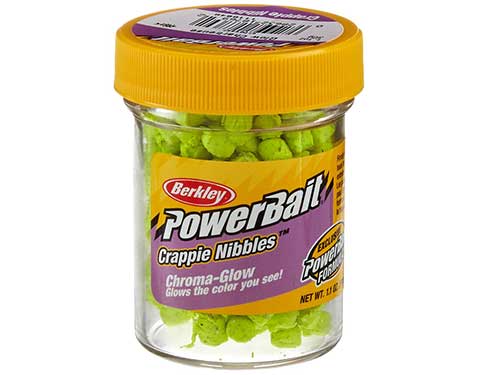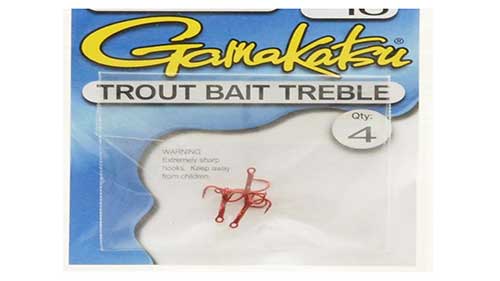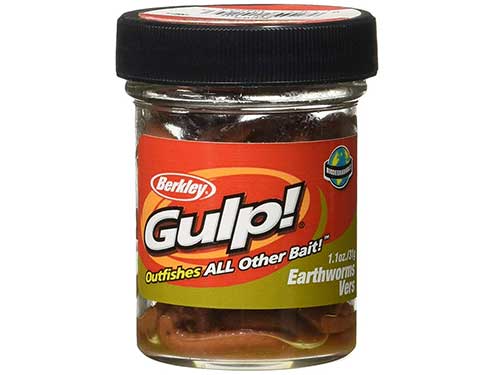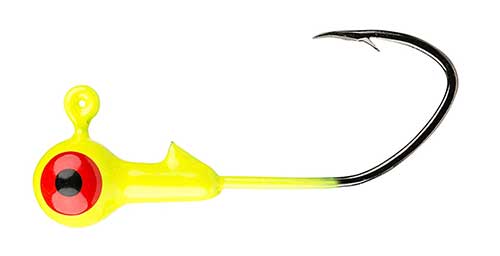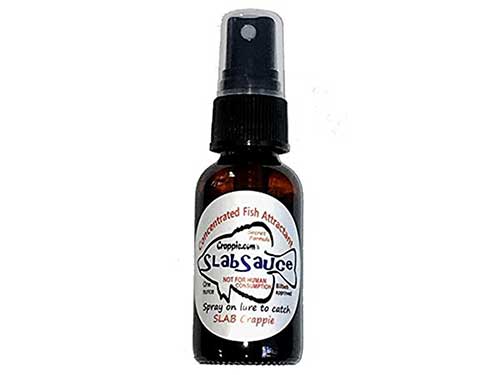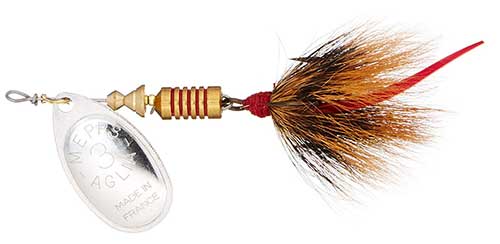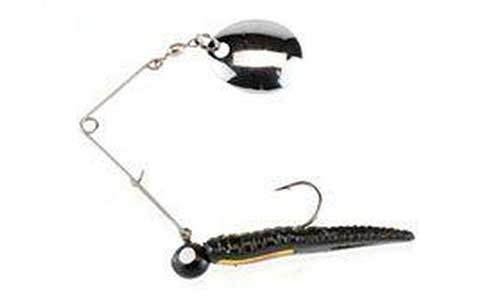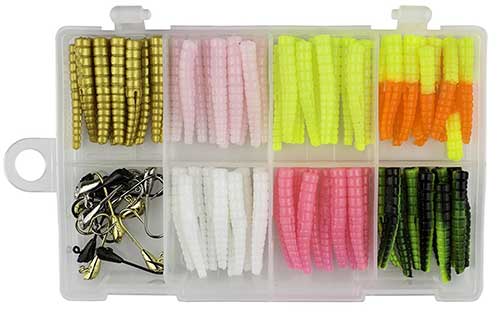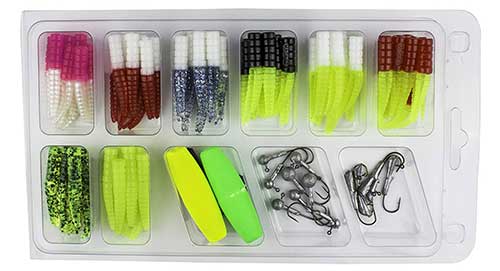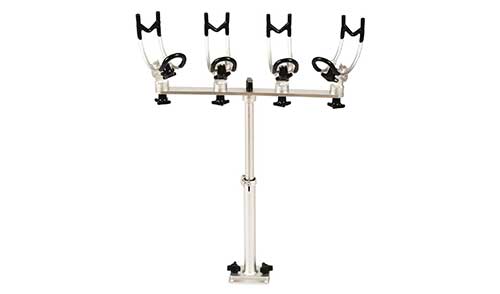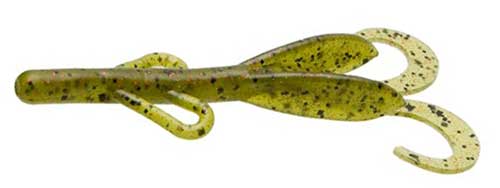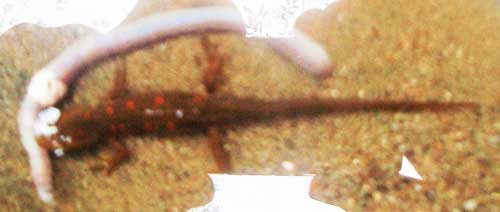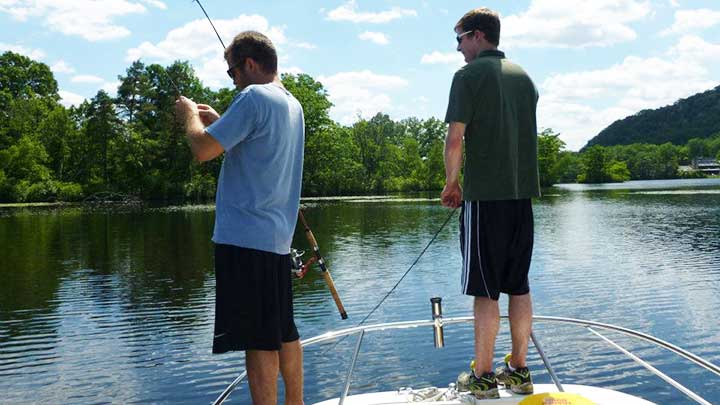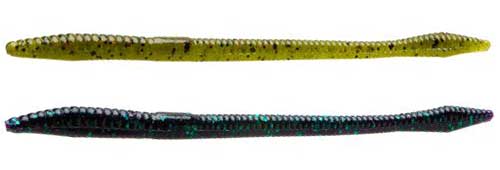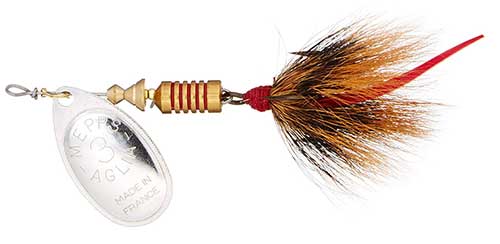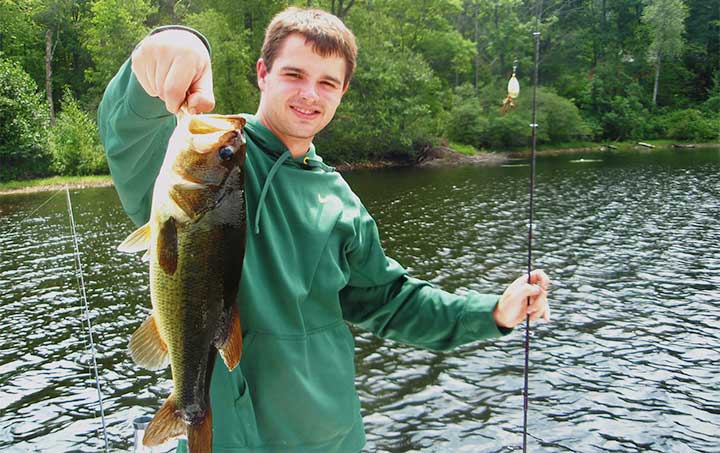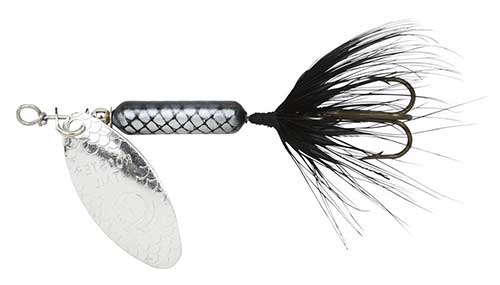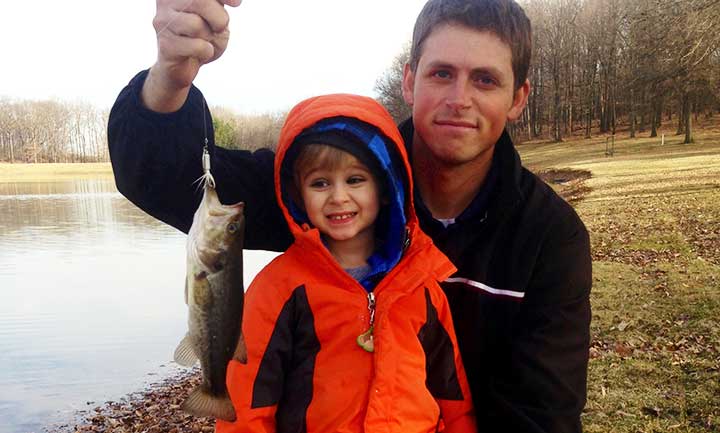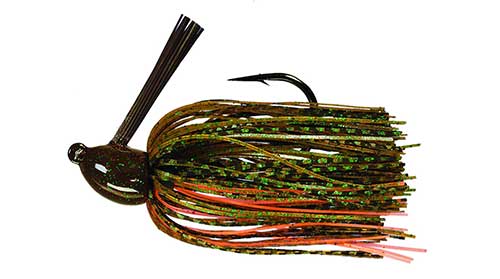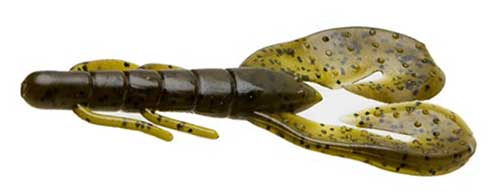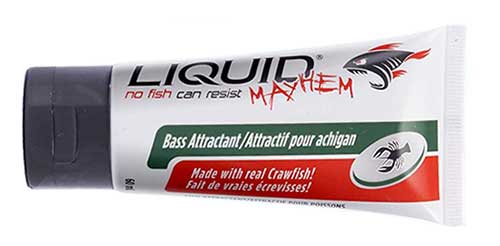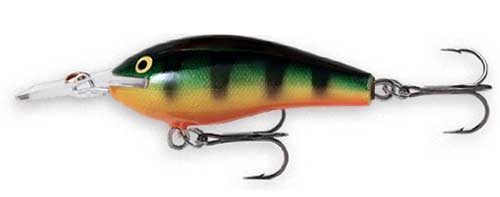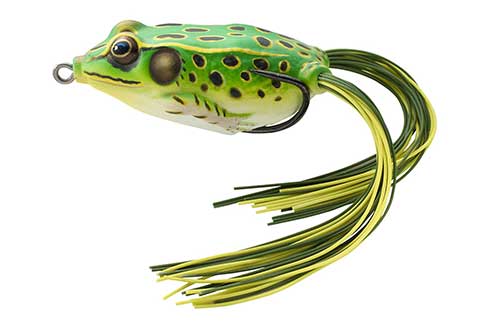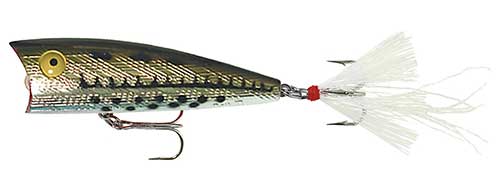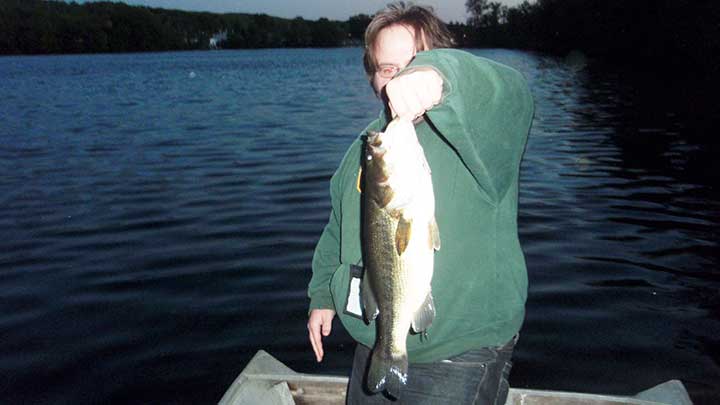Crappie fishing has come a long way since minnows on a float being the preferred method to catch crappie. Crappie has become a highly desirable sportfish that are a blast to catch on light tackle and are a good fish to keep for dinner.
Black crappie and white crappie are the only two types of crappie. They have many other nicknames though including papermouths, speckled perch, speckled bass, calico bass, and strawberry bass. Crappie are common in lakes in all 48 continental states.
Crappie lay between 5,000-40,000 eggs. The fish mature in two to three years and typically live seven years. These fish are abundant, frequently swim in schools, and can be a very fun fish to target if the right tactics are utilized. The world record white crappie was caught in 1957 in Mississippi and weighed 5 pounds 3 ounces. The world record black crappie was caught in 2018 in Tennesse and weighed 5 pounds 7 ounces.
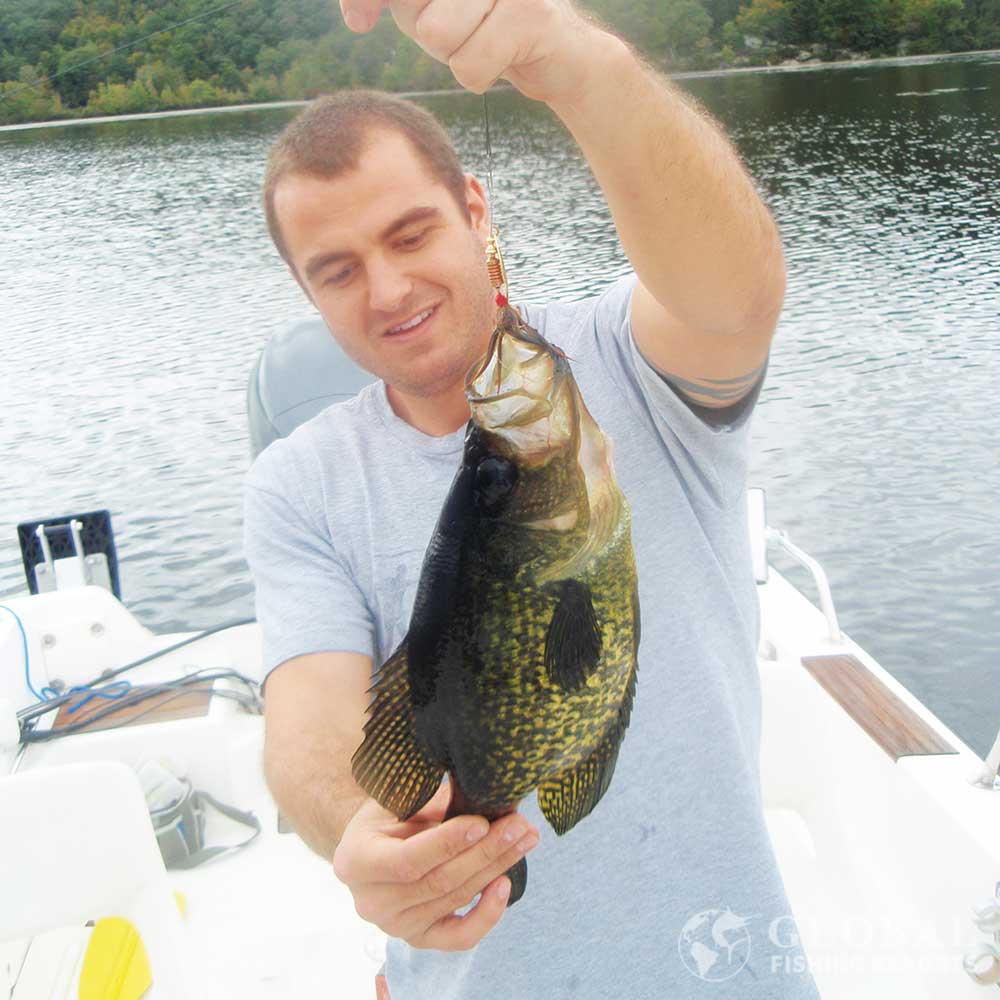
Understanding Crappie Behavior
In the summertime, crappie frequently surface feed in lakes during the early morning and about 1 hour before sunset. The crappie that surface feed can be of all sizes and feed on larvae and insects. When these fish are surface feeding they cannot typically be caught with large lures.
Crappies also feed heavily at night. Adding light to the water helps catch crappie at night. Minnows and scented jigs are both great options to catch crappie at night. Some jigs and crappie nibbles glow in the dark which can help catch more fish at night.
Typically, crappies are right up against downed trees, brush piles, ledges, or any other significant structure. Water temperature variations do move the depth of the structure that will be holding fish. Side-scan sonar is a great tool to help find structures that hold fish. Crappie will typically stay stationary near structure and ambush their prey such as shad, minnows, and crayfish. When fishing for bass I know the areas in the lake where crappie are going to bite. Once locations that hold crappies are found they can be caught consistently.
Effective Crappie Fishing Techniques
Spider Rigging
Spider rigging is very popular for people that are serious about crappie fishing. An array of about 8 fishing poles that are 9 to 14 feet long are spread out around the front of the boat. Each pole is generally set at different depths. Typically minnows with a hook, scented jigs, jigs tipped with minnows or jigs tipped with crappie nibbles are used. Slider weights are used to set the lines deeper.
Slow Trolling
Slow trolling can also be an effective technique and does not require as much gear as spider rigging. This technique works particularly well when crappie are suspended in the water column.
Targeting Structure
Casting around known structure with small jigs and lures is a proven method. The structure can be submerged debris, tree roots, stumps, ledges, or docks. Some people even sink Christmas trees tied to bricks to create a bottom structure near where they fish.
Night Fishing
Using lights to attract baitfish and subsequently crappie is highly effective at night. Scented and glow baits are used on a float to catch crappie near the light.
Effective Fishing Methods for Crappie
Scented Crappie Baits
Berkley Crappie Nibbles
Crappie nibbles come in glow chartreuse, glow pink, glow white, and glow yellow. These colors work during the day but are great for low-light conditions and night fishing. Crappie are most active during, dawn, dusk, and nighttime so glow baits are often a great option. Crappie nibbles also come in non-glow colors of chartreuse, pink, white, yellow, and a variety of colors with sparkle glitter.
This bait can be used without a jig similar to how PowerBait is used to fish for trout on a small treble hook. Generally, this bait is used by placing a nibble on the tip of jigs or placed within tube jigs to add scent. This often increases the number of fish caught.
Adding scent and glow to bait is especially important when fishing for crappie at night. Tipping jigs with minnows might be slightly better but for convenience and portability reasons, PowerBait is the best option in many cases.
Treble Hooks for Crappie Nibbles
The small trout bait treble hooks come in sizes 14, 16, and 18. Size 14 is the larger hooks and is what I would recommend in most cases. If you use a small size 18 hook the bait will actually float on the surface of the water.
If crappie are eating bugs off the surface then a small floating bait is a great option to catch small crappie. Surface flies and fly poopers would also be good options when crappie are surface feeding. When crappie are surface feeding they tend not to bite large lures so crappie nibbles on a hook is a good option.
Floats for Crappie Baits and Jigs
These trout magnet floats come in a 4 pack or 36 pack. This float is a small foam bobber that works great to suspend small jigs and baits when crappie fishing. Crappie are often suspended in the water column and the depth of the lure can be set using the float.
The proper depth to target crappie can be found by marking them on the fish finder or by setting lines to multiple depths initially to try and locate fish. When a fish bites the bobber can be pulled down or pulled horizontally and the line should be pulled tight as quickly as possible.
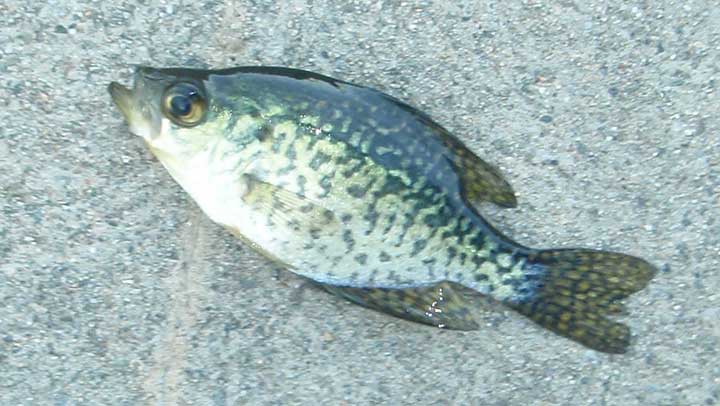
Berkley Gulp Earthworm
Berkley Gulp earthworms are 4 inches in length and come in a 1.1-ounce container. The two types are brown and red wigglers. Gulp has great scent dispersion that can expand the strike zone of fish.
These earthworms are a great way to add scent to crappie jigs. These jigs can be cut in half or into four pieces to tip jigs. This is especially a good idea to do when fishing jigs on a small float. Worms are one of the best baits to use for all freshwater fish. This is also a great bait to use with kids because the sent does most of the work to get the fish to bite.
PowerBait Power Minnow
The PowerBait Power Minnow comes in two sizes, a 1/32 ounce jig on a 2-inch bait and a 1/8 ounce jig on a 3-inch bait. These come in colors of black shad, firetiger, and smelt. The two-inch baits come with 2 jigs and 10 bodies and the three-inch baits come with 2 jigs and 8 bodies. From Bass Pro Shops it comes with more bodies but no jig heads.
These jigs are fantastic for crappie and are a great alternative to using live minnows. These baits are scented and have a life-like presentation in the water. Small shad are one of the crappie’s favorite food and this bait is a great imitation of a shad. This comes with properly sized jigs for bodies so this scented bait comes ready to fish. The 2-inch baits are great for pitching under docks and near structure in shallow water. The three-inch baits are good for slow trolling and drifting to target deeper fish.
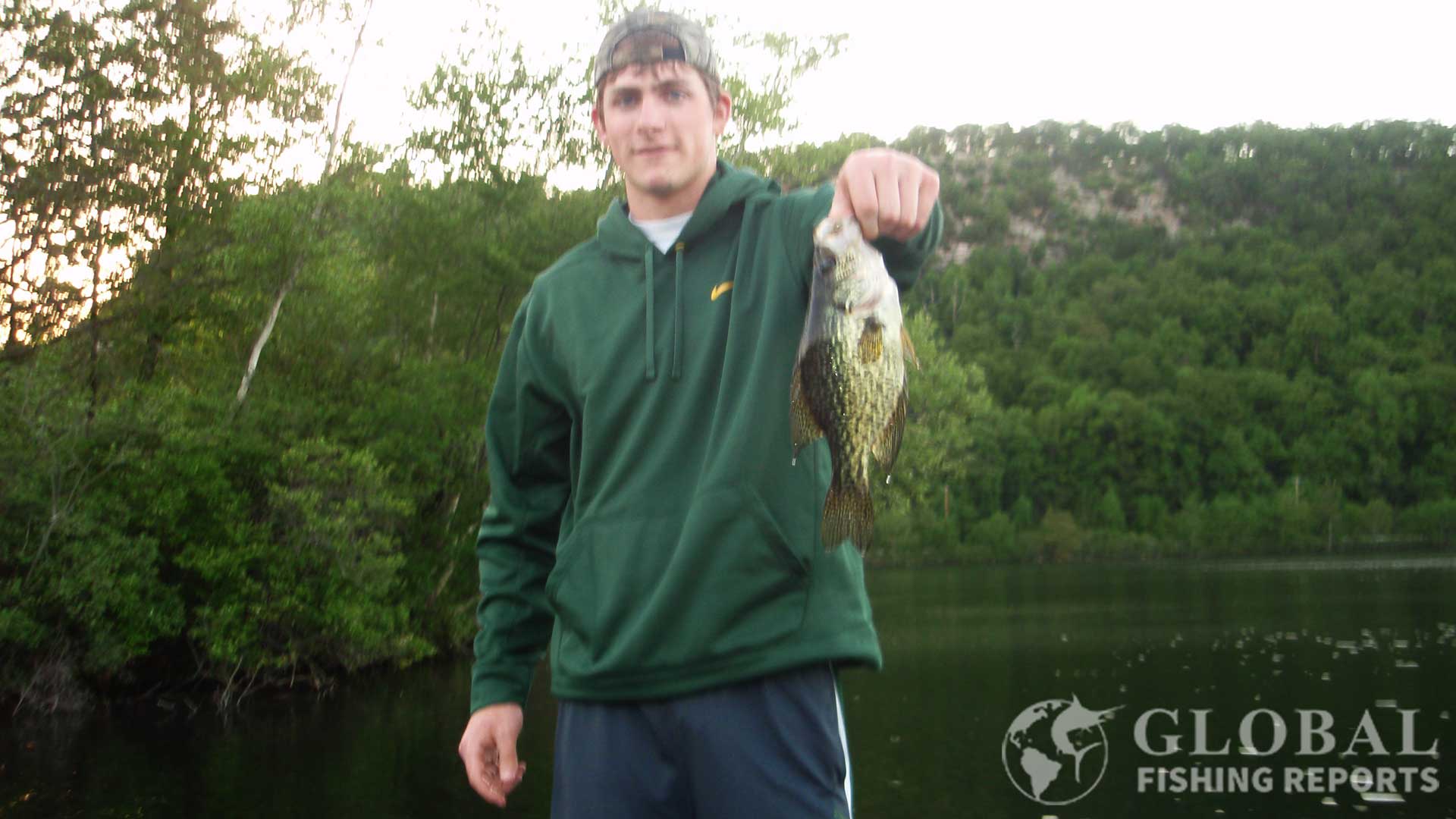
Emerald Shiner Gulp Alive Minnow
These Berkley Gulp Alive Minnows are 1-inch in length. These come in color options of emerald shiner, chartreuse, Luma Glow, and Smelt. These are all great color options for crappie.
If you have ever used gulp scented baits before you know they do not disappoint and often outfish live bait. I really like Berkley Gulp Alive Minnows but the jig heads need to be purchased separately. The trout magnet gig heads below are a great size for this 1-inch bait.
Trout Magnet Jig Heads
The trout magnet jig heads are painted silver and weigh 1/64 of an ounce. These are great jigheads to use with 1-inch crappie baits. These jigs are lightweight so a 4-pound test line should be used so these can be cast a decent distance. A small flat can also be used with the bait so the jig can be cast further.
Bobby Garland Baby Shad
Bobby Garland Baby Shad Crappie Baits are 2 inches in length and come in over 50 patterns including glow-in-the-dark patterns. These size 0 bodies come in packs of 18.
Bobby Garland Baby Shad baits are a very popular crappie jig. These small baits are good for catching non-aggressive fish and can be fished year-round. They are not scented and tipping them with a minnow or Crappie Nibbles is a good idea. Spraying them with crappie slab sauce spray is also a good way to add scent. Monkey Milk and Blue Thunder are two popular colors.
Mr. Crappie Slab Slasher Jig Heads
Mr. Crappie jig heads come in colors of chartreuse, fluorescent orange, limetruse, pink, refrigerator white, and unpainted. These come in sizes of 1/32 ounce, 1/16 ounce, and 1/8 ounce. The size 1/16 ounce works the best with the 2-inch shade bait and is the most popular size jig for crappie. These jigs have large painted white or red eyes. These are rigged with nickel eagle claw hooks and come with 8 jigs per pack.
Crappie Slab Sauce Spray Scent
SlabSauce fish attractant is a great way to add scent to a bait. Many people overlook adding scent to baits when freshwater fishing. Fish feed using the sense of sight, vibrations using their lateral line, and smell to find food. When fish get close to a bait scent can definitely increase the chance that fish will strike the bait.
In the video below Richard Gene is using the Bobby Garland baby shad to catch fish that are suspended under-structure.
Crappie Spinner Baits
Mepps Spinner
Mepps spinners from size 0 to size 3 are great for crappie. Size 0 weighs 1/12 of an ounce, size 1 weighs 1/8 of an ounce, size 2 weighs 1/6 of an ounce, and size 3 weighs 1/4 of an ounce. I am a huge Mepps fan and often use a size three because it works great for crappie and bass. Crappie have paper-thin mouths though so fight them less aggressively than you would a big bass. Using a Mepps spinner is a great way to cover lots of shallow water and find fish.
Johnson Beetle Mini Spinner Bait
The Johnson Beetle comes in weights of 1/32 ounce, 1/16 ounce, 1/8 ounce, and 1/4 ounce. My favorite size for crappie is the 1/16 ounce size. On the 1/16-ounce lure, the bait body is 1-1/8 inches in length. In order to be able to cast this lure far a light line with a 4-6 pound test should be used.
This is a great little spinner that is a must-have for the tackle box. It will catch most freshwater fish and works especially good on crappie. Black works well in low light conditions and murky water and white works well during the day. This lure can have the rubber jig swapped with a gulp shad to add scent to the lure. This is especially important when fishing at night.
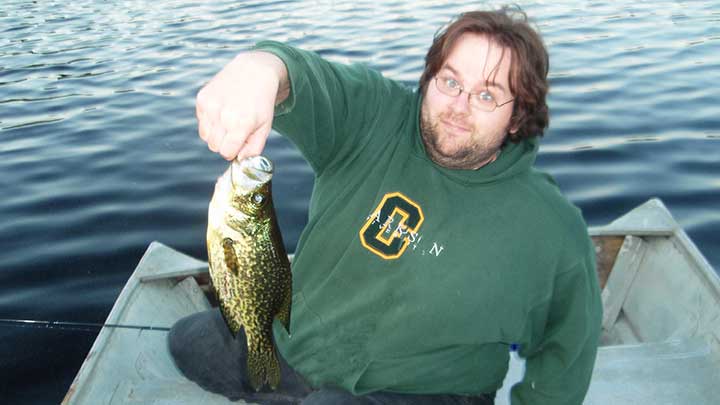
Crappie Jigs
Trout Magnet Crappie Jigs
The trout magnet kit comes with 15 jig heads that are black, silver, or gold. There are 7 different body colors including, gold, bubblegum, chartreuse, white, pink, black-green, and chartreuse-orange. The jig heads are 1/64 of an ounce with size 8 hooks. The bodies are 1-1/4 inches in length. When rigging, the hook of the jig should exit the jig right where the tail on the body splits.
Trout magnets are my favorite mini-jigs to use for trout, crappie, bluegill, and perch. The jigs are only 1/64 of an ounce so a 4-pound test fishing line is recommended so the jigs can be cast. These jigs do not have a scent but can be tipped with crappie nibbles, minnows, worms, or sprayed with crappie slab sauce. A scent does not need to be added and these jigs work well while slowly retrieving the jig that is suspended on a small foam float.
Crappie Magnet Jigs
The crappie magnet kit comes with 1/32 ounce and 1/16 ounce jig heads and two foam floats. The body of these jigs is 1-1/2 inches in length. The crappie magnet bodies are 1/4 inch longer than the trout magnet and are also wider.
These baits are two-tone which is very common for crappie fishing. Crappie are known for biting better on different color baits depending on the lighting levels and water clarity. Having two colors makes it more likely a color will be presented that the fish likes. Chartreuse, white, and pink are probably the most popular crappie colors. Brown and black work good if the water is stained or murky. These are not scented baits so tipping the jig with a scented bait is a good idea.
Mr. Crappie Sausage Jig Head
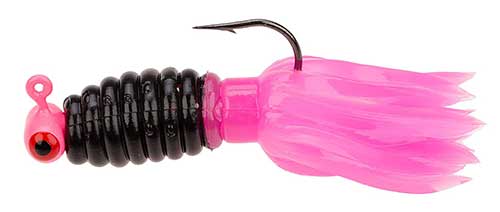
The strike king Mr. Crappie sausage head jig head comes in 1/16 ounce and 1/8 ounce sizes. Color options include hot chicken, osage orange, pink tuxedo, refrigerator white, and tuxedo black. These jigs come in packs of three.
Sausage head jigs are rigged with Eagle Claw laser-sharp platinum black hooks. This is a large profile bait that works well when fish a striking based on sight. This is a good bait for casting and vertical jigging. When looking at this jig its large profile stands out. Both the football-shaped sausage body and wide tail give it a great presentation in the water even when it is not moving. This bait is not scented so tipping the jig or adding scent is a good idea.
Johnson Crappie Buster Spin Grub
The Johnson Crappie Buster is another classic crappie bait. This bait comes in sizes of 1/32 ounce, 1/16 ounce, and 1/8 ounce. The jig has a single chrome blade on a ball bearing swivel which adds flash and vibrations. The standard body has a curly grub tail which has great action. Color options include black-fluorescent orange, chartreuse, fluorescent red-chartreuse sparkle, fluorescent red-white, pink-pearl, white-hot pink, and white.
These baits work well in all weather conditions. They can also be slow trolled. In the video below crappie are caught while slowly drifting several different types of jigs. The baits are tipped with minnows in this case with many poles set out at different depths. Controlling the depth of the baits is important. In the summertime and winter fish can be deeper in the water column. In lakes that stay stained and murky crappie tend to stay suspended year-round and trolling can be an effective way to catch crappie.
Lure Selection Based on Conditions
Clear Water Conditions
When fishing in clear water, I’ve found natural colors and smaller profiles work best. Minnow imitations, silver/chrome spinners, and translucent soft plastics generally outperform other options. The fish can see the bait from further away, so more subtle presentations are key. Some of my go-to lures for clear water include:
- Glass minnow patterns
- Silver or chrome bladed spinners
- Translucent tube jigs
- Natural colored soft plastics
Best clear water crappie lures list goes here
Stained or Murky Water
In stained or murky water, high-visibility colors and lures that create vibration through the water help crappie find your offering. The reduced visibility means crappie rely more on their lateral line to detect prey. My preferred lures for these conditions include:
- Chartreuse, orange, or white colored jigs
- Spinners with large blades
- Scented baits that leave a stronger trail
- Lures with rattles or vibration
Best stained water crappie lures list goes here
Night Fishing Conditions
When fishing at night, glow-in-the-dark baits and lures with strong vibration patterns are essential. Since crappie feed heavily at night, this can be one of the most productive times to fish. My night fishing arsenal typically includes:
- Glow jigs and crappie nibbles
- Black spinners (silhouette against night sky)
- Lighted floats to detect strikes
- Scented baits
Best night fishing crappie lures list goes here
Seasonal Considerations
Crappie behavior changes dramatically with the seasons, and your lure selection should adjust accordingly:
Spring (Spawning Season)
During the spawn, crappie move to shallow water and become more aggressive. Small minnows and jigs worked slowly around structure can be devastating.
Summer
As water temperatures rise, crappie often move deeper but will surface feed early and late in the day. Having both shallow and deeper presentations ready is key.
Fall
Fall brings crappie back to the shallows as they feed heavily before winter. This is a great time for aggressive presentations with spinners and crankbaits.
Winter
In winter, slow-moving presentations at the right depth are crucial. Small jigs tipped with live bait or scent and fished very slowly produce the best results.
Crappie Fishing Gear
Fishing for crappie can be done with one short light action rod, lightweight reel, a single lure and you are set up to fish. It can also be as complicated as running 8 or more 14-foot rods while spider rigging with two baits setups on each line. For most anglers, the best setup is somewhere in between. Having about three fishing rods setup and ready to fish helps catch more fish while still being an enjoyable activity.
When crappie fishing it is also common to catch bass, perch, hybrid striped bass, walleye, and pickerel.
Specialized Equipment
Crappie Night Light
This is a 12 volt 1000 lumen light that shines 360 degrees. The light comes with battery clips, a 6m power plug, and a power cord. The color options are white, blue, and green. I would recommend getting a white light.
Fishing for crappie at night is a popular and fun way to catch crappie. Using an underwater light is almost a guaranteed way to catch more fish. Lights above the surface will work but typically attracts many unwanted bugs. Underwater lights attract small aquatic insects, krill, phytoplankton, and insects to the surface of the water. These small creatures attract baitfish and the baitfish attract the predator fish like crappie.
Spider Rigging Rod Holders
Four poles Millennium Spyder fishing rod holders for spider rigging. These are all aluminum with a 24-inch crossbar. The height is easily adjustable without tools and each pole holder has independent vertical rotation making it easy to change the depth of each pole independently. The crossbar can also rotate 360 degrees.
Serious crappie fishermen use the spider-rigging method for drifting and trolling for crappie. The basic equipment needed includes rod holders and two or more long poles. A fish finder and trolling motor with auto-pilot are typically used to help navigate the bottom structure. Long fishing poles are not required but help spread out the baits. Poles from 9 feet to 16 feet are typically used for spider-rigging. Bass Pro Shops also has a nice spider rigging rod holder.
Crappie Spinning Pole
Berkley C-Series Crappie spinning pole is great for spider-rigging setups. Poles come in 11 feet, 12 feet, and 14 feet lengths. The poles are two-piece or three-piece which allows for easy transport.
The rod holders and poles are the basic items needed to get into spider-rigging for crappie. There are many great instructional videos online about techniques and ways to easily know the depths of each pole relative to the bottom. Check out the page I wrote about ultralight fishing reels.
Common questions about crappie fishing.
What is the best way to catch crappie?
The way professional anglers fish for crappie is typically spider rigging. Up to eight poles are set per person and each pole can have two baits. A side sonar is used to locate fish and structure that might hold crappie. A trolling motor with autopilot helps troll and navigate the water. This method works best when fish are suspended in 6 feet to 20 feet of water. In early summer when crappie spawns the best place to fish is near structure in shallow water.
How do you fish for crappie at night?
Crappie are caught at night by first using light to attract bait to the area. Cappie are then attracted by the commotion of the bait. Scented baits and glow in the dark baits are used to catch the crappie at night. The baits are typically suspended in the water on a foam float or bobber with a light. The baits are cast in the areas around the light not directly in the light. Each person can use multiple fishing poles.
What time of day is best for crappie fishing?
The best time of day to fish for crappie is at dawn, dusk, and at night. This is when crappie are the most active and typically search for food. Crappie are opportunistic feeders and will feed during the day as well. Having good bait helps to encourage crappie to bite during the day.
Are crappie attracted to light?
Yes, but not directly to the light itself. The light attracts zooplankton, aquatic insects and insects. These creatures are food for baitfish like shad and minnows. The action of the baitfish is what attracts the crappie. If the bait does not show up in the area it is unlikely the crappie will be drawn toward the light.
Will crappie bite worms?
Yes, crappie will absolutely eat worms. Worms are not frequently eaten by crappie but if given the change crappie will eat worms. Worms are not are typically fished by themselves for crappie but are added to the tip of jigs to add scent.
What is crappie favorite food?
Adult crappie’s favorite food is shad, minnows, and crayfish. Crappie will also eat insects and crustaceans. Juvenile crappie feed on zooplankton and small invertebrates like aquatic insects and bugs.
What size hooks for crappie?
The best size hooks for crappie using live bait is size 6 through size 1, with size 6 being the smallest hooks. Crappie have large enough mouths to bite hooks as large as 3/0 that are commonly used on large bass baits. Crappie have paper-thin mouths and when a small hook is used the fish should gently be reeled in. Hard jerks of the pole will tear the hook out of the mouth of the fish.
Can you troll for crappie?
Yes, trolling for crappie can be an effective way to catch crappie. Especially when fish are suspended in the water column. Many lines can be sent out the back or trolled with spider rigs on the front of a boat. The boat is trolled at a speed of about 1 mile per hour until fish are marked. The boat is then slowed to about .1 miles per hour. Typically lures are scented jigs and jigs tipped with minnows.
What are the types of crappie?
There are two types of crappie which are black crappie and white crappie. However, crappie have many nicknames including papermouths, speckled perch, speckled bass, calico bass, and strawberry bass. Black crappie and white crappie are found throughout the united states and are similarly sized fish. Adult white crappie feeds on more fish than white crappie whose diet consists heavily of insects and crustaceans.
Conclusion
Crappie fishing combines the excitement of sport fishing with the delicious reward of a tasty meal. By understanding crappie behavior, selecting the right gear for conditions, and employing proven techniques, you can dramatically increase your success on the water. Whether you’re spider rigging from a boat or casting from shore, these paper-mouthed panfish offer accessible fun for anglers of all skill levels.
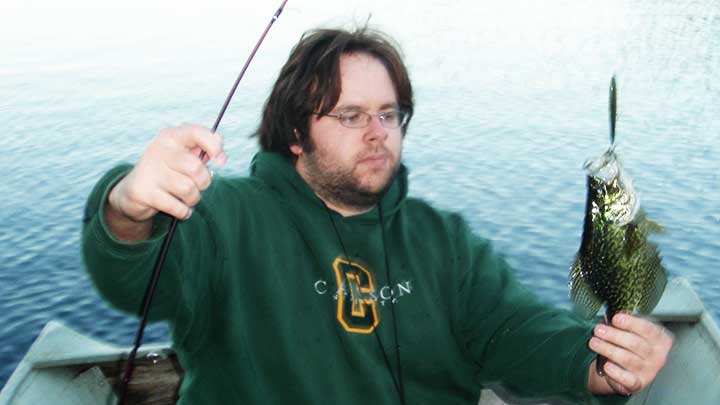
Captain Cody has worked on charter fishing boats in the Florida Keys, Virgin Islands, and Alaska. Growing up in Pennsylvania Cody has also done extensive freshwater fishing including bass fishing tournaments. Cody strives to provide detailed information about the best fishing gear and tactics to help both novice and experienced anglers have a more productive and enjoyable time on the water. Cody also has a background in aerospace engineering and neuroscience but really only takes pride in being good at one thing and that is fishing!

